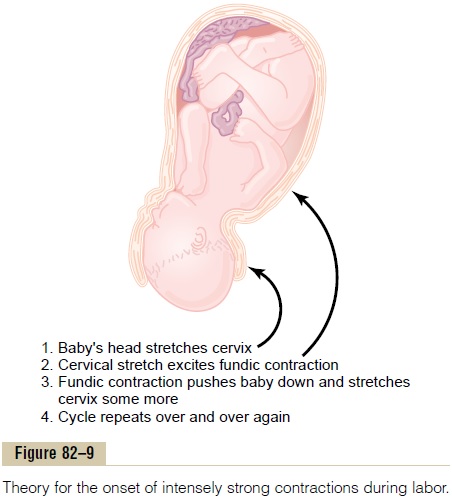Chapter: Medical Physiology: Pregnancy and Lactation
Onset of Labor-A Positive Feedback Mechanism for Its Initiation - Parturition
Onset of Labor-A Positive Feedback Mechanism for Its Initiation
During most of the months of pregnancy, the uterus undergoes periodic episodes of weak and slow rhyth-mical contractions calledBraxton Hicks contractions.
These contractions become progressively stronger toward the end of pregnancy; then they change sud-denly, within hours, to become exceptionally strong contractions that start stretching the cervix and later force the baby through the birth canal, thereby causing parturition. This process is called labor, and the strong contractions that result in final parturition are called labor contractions.
We do not know what suddenly changes the slow, weak rhythmicity of the uterus into strong labor con-tractions. However, based on experience with other types of physiological control systems, a theory has been proposed for explaining the onset of labor. Thepositive feedback theory suggests that stretching ofthe cervix by the fetus’s head finally becomes great enough to elicit a strong reflex increase in contractil-ity of the uterine body. This pushes the baby forward, which stretches the cervix more and initiates more positive feedback to the uterine body. Thus, the process repeats until the baby is expelled. This theory is shown in Figure 82–9, and the observations sup-porting it are the following.

First, labor contractions obey all the principles of positive feedback. That is, once the strength of uterine contraction becomes greater than a critical value, each contraction leads to subsequent contractions that become stronger and stronger until maximum effect is achieved.
Second, two known types of positive feedback increase uterine contractions during labor: (1) Stretch-ing of the cervix causes the entire body of the uterus to contract, and this contraction stretches the cervix even more because of the downward thrust of the baby’s head. (2) Cervical stretching also causes the pituitary gland to secrete oxytocin, which is another means for increasing uterine contractility.
To summarize, we can assume that multiple factors increase the contractility of the uterus toward the end of pregnancy. Eventually a uterine contraction becomes strong enough to irritate the uterus, espe-cially at the cervix, and this increases uterine contractility still more because of positive feedback, resulting in a second uterine contraction stronger than the first, a third stronger than the second, and so forth. Once these contractions become strong enough to cause this type of feedback, with each succeeding con-traction greater than the preceding one, the process proceeds to completion—all because positive feedbackinitiates a vicious circle when the gain of the feedback is greater than a critical level.
One might ask about the many instances of false labor, in which the contractions become stronger and stronger and then fade away. Remember that for a vicious circle to continue, each new cycle of the posi-tive feedback must be stronger than the previous one. If at any time after labor starts some contractions fail to re-excite the uterus sufficiently, the positive feed-back could go into a retrograde decline, and the labor contractions would fade away.
Related Topics